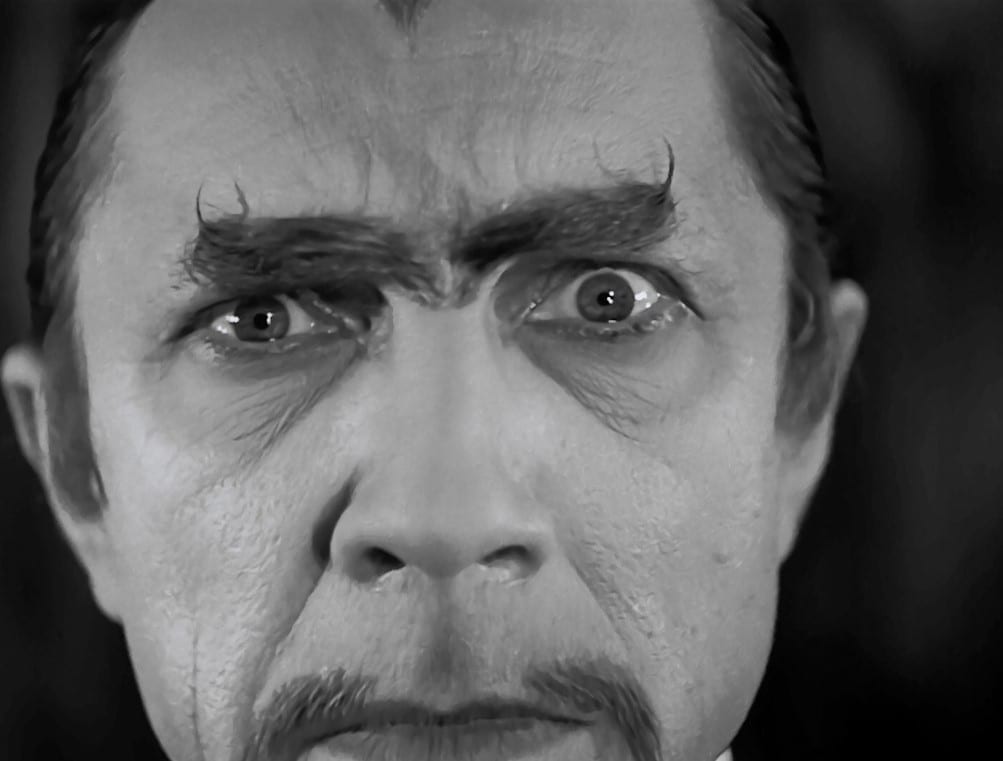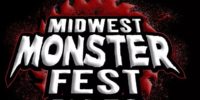The horror genre owes an almost incalculable debt to Bela Lugosi. His portrayal of Dracula set the template for every subsequent adaptation of the character as well as our culture’s image of vampires in general. To take just one example of his tremendous influence, if you’ve ever tried to talk like a vampire with a Transylvanian accent, you were actually imitating Bela Lugosi’s Hungarian accent. His portrayal of Dracula is so iconic that pretty much everything about it, including the way he spoke, became part of our collective understanding of the character.
But Lugosi was more than just Dracula. He was a fantastic actor, and he played a number of other horror roles that were just as great even though they didn’t become nearly as famous. He was a staple of the genre throughout the ‘30s and ‘40s and even into the ‘50s, and he elevated every movie he was in, no matter if he was the star or just a side character. Other than maybe Boris Karloff, he was hands down the best horror actor of his generation, so here are five of his best performances that prove there was way more to him than just a single vampiric role.
Murders in the Rue Morgue

Murders in the Rue Morgue is a 1932 movie based loosely on the Edgar Allen Poe story of the same name. In it, Bela Lugosi plays a carnival sideshow worker named Dr. Mirakle who kidnaps women and injects them with ape blood to make a mate for his pet gorilla, Erik. None of the women ever survive this procedure, so he has to keep looking for more victims to subject to his barbarous experiments.
This film is all about Bela Lugosi’s performance. The plot feels rushed at times, and most of the other characters are a bit bland, but Dr. Mirakle is a real treat to watch. He ranges from subtly sinister to straight up evil, and Lugosi pulls off both extremes perfectly. You really believe that he’s a mad scientist trying to create a human-ape hybrid, so he grounds the story with a sense of believability that makes you buy into it from the very first moment he’s onscreen.
In particular, there are two scenes where he really gets a chance to shine. First, when Dr. Mirakle is at the carnival showing off Erik to a curious audience, Lugosi commands the spotlight in a way that captivates you and glues your eyes to the screen. He’s so charismatic that you feel like you could watch an entire movie of him just talking on stage, and you would never get bored.
Soon afterward, you see Dr. Mirakle inject his first victim with Erik’s blood, and Lugosi shows off an impressive emotional range with the character. First, he masterfully conveys Mirakle’s fanatical obsession with finding a suitable mate for his ape, and he lets you know without a doubt that the doctor doesn’t care one lick about the woman’s wellbeing or even her life. Then, when Mirakle realizes that his subject has died, Lugosi does a complete 180 and communicates an equally deep sense of despair at ever reaching his goal.
Unfortunately, after those two scenes, Lugosi doesn’t get another opportunity to show off his acting chops to quite the same extent, but he still gets enough screen time to keep the movie afloat. In short, Murders in the Rue Morgue is a perfect example of what makes Bela Lugosi such a legend of the genre. He had an uncanny ability to take an otherwise unexceptional movie and make it a classic almost exclusively on the strength of his stellar performance, and that’s exactly what he did with this one.
White Zombie

White Zombie is the first zombie movie ever made, predating Night of the Living Dead by more than thirty years. In this film, zombies are products of voodoo magic, not some sort of virus or scientific anomaly, and they’re not the flesh-eating ghouls that George Romero popularized. They’re mindless slaves of a man named Murder Legendre, played to chilling perfection by Bela Lugosi, and they do whatever he tells them to do. The movie follows a young couple who go to Haiti to get married, and soon afterward, the wife falls victim to Legendre and becomes one of these zombies.
Like Murders in the Rue Morgue, this film also works almost entirely because of Bela Lugosi’s outstanding performance. The plot is rather humdrum, and the other actors are decent at best, but Murder Legendre is absolutely enthralling. Much of what I said about Dr. Mirakle also applies to this character, so I won’t repeat myself too much. Suffice it to say, White Zombie is at its best whenever Legendre is on screen, whether he’s commanding his undead servants to kill someone or he’s just sitting at a table and talking.
Thankfully, we never go too long without seeing him. Unlike Murders in the Rue Morgue, this film doesn’t concentrate Lugosi’s best scenes at the beginning. His screen time is spread out more evenly throughout the movie, so it never spends more time on the inferior elements than it needs to. Whenever it focuses on the other characters, it gives you just enough to keep the story moving, and then it goes back to Legendre, the real star of the show.
In a nutshell, White Zombie is another great showcase of Lugosi’s tremendous acting talent. Only the best actors can make a movie a classic on the strength of their performance alone, and this movie demonstrates once again that Bela Lugosi belonged to that very exclusive group.
Island of Lost Souls

Island of Lost Souls is an adaptation of the classic H. G. Wells novel, The Island of Dr. Moreau. It’s about a man who finds himself on an island where a scientist named Dr. Moreau is conducting experiments to greatly accelerate evolution in the native animals, turning them into very odd looking human beings. Dr. Moreau leads these animal people with an almost cult-like iron fist, but when this new visitor arrives, he challenges the status quo on the island.
Bela Lugosi has only a small part in this movie, playing one of these rapidly evolved animals, so there’s admittedly not much to say about his performance. However, I can say that despite Lugosi’s paucity of screen time, he still elevates every scene he’s in. He shows the same charming charisma, the same “it” factor, that he displays in his other movies, so he makes a much bigger impact than his small role would suggest. He’s just as much of a pleasure to watch here as he always is, and he makes you remember his character almost as if he were a major player.
Simply put, this film shows that Bela Lugosi didn’t need top billing to elevate a movie. Island of Lost Souls is a bona fide horror classic even apart from his performance, but he makes it even better. He leaves an impression with only a handful of scenes, demonstrating once again that he’s one of the best the genre has ever seen.
The Raven

There are several horror movies called The Raven, but the one I’m talking about here is a 1935 in-name-only adaptation of Edgar Allen Poe’s classic poem. It stars both Bela Lugosi and Boris Karloff, although Lugosi gets the juicier role by far. He plays a renowned surgeon, Dr. Richard Vollin, who’s so obsessed with Edgar Allen Poe that he actually builds the torture devices Poe wrote about, and when he’s rejected by the father of a young woman he’s recently fallen in love with, he hatches a plan to use those devices to get revenge.
When the film begins, Dr. Vollin seems pretty normal. In fact, he’s a pretty good guy. He uses his surgical ability to make the world a better place, so you don’t expect him to be the villain of the movie. But once he’s rejected by the girl’s father, that all changes. He soon becomes unhinged, and Lugosi gets a chance to flex his acting muscles once again.
However, this role is a bit different than the other ones we’ve looked at in this list. Dr. Vollin doesn’t just do terrible things; he also gets a perverse pleasure from seeing people in pain. He’s fascinated by torture, and just the thought of it makes him almost giddy with joy. For example, there’s a great scene where he brings Karloff’s character to his torture chamber and shows him some of the devices he’s made, and his smile grows bigger and bigger as he explains how one of them works.
By the end of the movie, Vollin is stark raving mad, and predictably, Bela Lugosi plays the part perfectly. In fact, he’s so convincing that you almost think he loves torture just as much as his character does. He clearly relishes the role, and that enjoyment inevitably rubs off on you when you watch him. Once again, Lugosi’s performance is the best thing about the film, and his sinister villain is a huge part of the reason why The Raven is still a great watch almost a century later.
Son of Frankenstein

Son of Frankenstein is the last great Universal Studios Frankenstein movie. It’s not on the level of the first two, but it’s still a real treat to watch. In large part, that’s because this is Boris Karloff’s final time playing the monster. He was hands down the best performer to ever take on the role, and I always find the creature a bit disappointing when he’s played by other actors in the subsequent sequels.
However, Karloff isn’t the only reason this movie works so well. In fact, he doesn’t even give the best performance in it. That accolade goes to Bela Lugosi, who plays a new character named Ygor. He’s a convicted graverobber who somehow survived being hanged, and he’s found a way to control Frankenstein’s monster and make him kill the jurors who sentenced him to death.
This is quite possibly the best performance of Lugosi’s career, rivaling even his stellar work as Dracula. He becomes this character so completely that if you don’t already know it’s him, you very well might not realize it. He looks different, he talks differently, and he even moves differently, and he pulls it all off flawlessly. This is not the Bela Lugosi we’re used to seeing, and the character is all the better for it.
Lugosi injects Ygor with the same sinister attitude that many of his roles have, but with one key difference. Most of his characters have to hide their evil intentions so the protagonists don’t find out what they’re up to, but Ygor is a bit more open. Because he uses the monster to do his dirty work, there’s no real evidence against him for the bulk of the movie. He can smile and laugh as he denies any evil intentions, letting everyone know that he’s up to no good while leaving his accusers helpless to do anything about it. This smug, mocking attitude makes Ygor especially creepy, elevating him to the top tier of classic Universal Studios horror villains.
Much like Island of Lost Souls, Son of Frankenstein shows once again that Bela Lugosi didn’t need to be the star to make a positive impact on a movie. Even when he was just a side character, he always elevated the films he was in. Without him, this movie probably would’ve been merely good, but because of his incredible work as Ygor, he turned it into yet another classic entry in one of the greatest horror franchises of all time.



